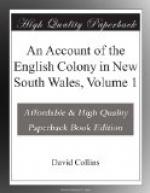About this time, the spirit of inquiry being on foot, Mr. Cummings, an officer of the corps, made an excursion to the southward of Botany Bay, and brought back with him some of the head bones of a marine animal, which, on inspection, Captain Paterson, the only naturalist in the country, pronounced to have belonged to the animal described by M. de Buffon, and named by him the Manatee. On this excursion Mr. Cummings received some information which led him to believe that the cattle that had been lost soon after our arrival were in existence. The natives who conversed with him were so particular in their account of having seen a large animal with horns, that he shortly after, taking some of them with him as guides, set off to seek them, but returned without success, not having met with any trace that could lead him to suppose they might ever be found.
On the 4th the Britannia returned from the Cape of Good Hope, having been absent six months and three days. Mr. Raven brought alive to his employers, one stallion, twenty-nine mares, three fillies, and twelve sheep. He sailed from the Cape with forty mares on board; but those that died were the worst, and had not been kept up long enough on dry food before they were embarked.
It was evident, on visiting the ship, that every attention had been paid to their accommodation; but horses were generally supposed better calculated than other cattle to endure the weather usually met with between the Cape and this country*.
[* It may be remembered, that in a former voyage to the Cape on a similar errand, she lost twenty-nine cows.]
We had the gratification of hearing that our fleet under Earl Howe had been victorious in a gallant and severe action with the enemy.
On the 15th, when anxiously expecting an arrival from England, we saw Mr. Dell come to anchor in the cove from Norfolk Island.
Though this arrival proved a disappointment to most of us, yet the information we received by it was rather interesting. We now learned, that Mr. Dell had been at New Zealand, where he passed three months in the river named by Captain Cook the Thames, employed in cutting spars, for the purpose (as was conjectured here at the time of his departure) of freighting such ship as might arrive from India on Mr. Bampton’s account. In the course of that time they cut down upwards of two hundred very fine trees, from sixty to one hundred and forty feet in length, fit for any use that the East India Company’s ships might require. The longest of these trees measured three feet and a half in the butt, and differed from the Norfolk Island pines in having the turpentine in the centre of the tree instead of between the bark and the wood. From the natives they received very little interruption, being only upon one occasion obliged to fire on them. Like other uncivilised people, these islanders saw no crime in theft, and stole some axes from the people employed on shore,




